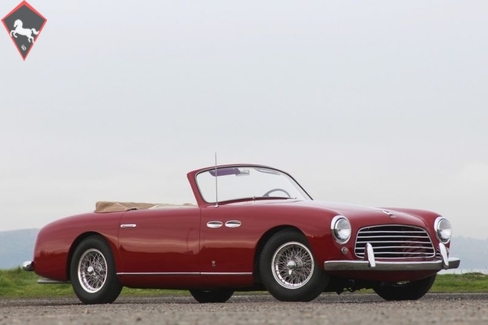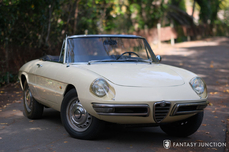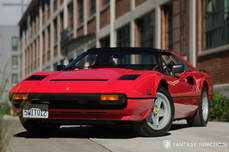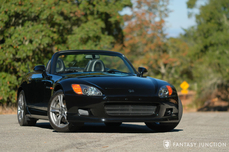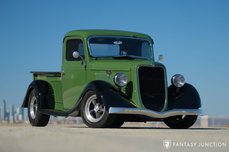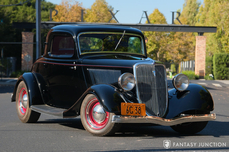Siata Other Ford V8 1952
Allgemeine Beschreibung :
1952 SIATA-Ford
s/n 208SL1006613
Red with Parchment
SIATA is among one of the most celebrated Italian car companies of the 1950’s. Known for their superbly crafted vehicles, the first production SIATA appeared in 1948. SIATA later built the iconic 208S and SC as well as the capable 300BC, many of which were formidable competitors on the track. But it was their stunning bodies, crafted by the finest coachbuilders of the period, which resulted in cars considered among the most beautiful of the 1950’s. SIATAs were frequently seen in competition both in Europe and the US, but were as much at home in elegant settings as they were on the Mille Miglia.
This stunning, one of a kind SIATA was originally commissioned by Jimmy Mulgrew of Euclid Ford, Euclid, Ohio. Mulgrew called on racecar driver Dick Irish (best known for his class win at Sebring, 1952 in a SIATA Daina 1400cc Gran Sport) who had been working with Mulgrew, proposing a plan to build a racecar on a modified Ford chassis. This car would serve both as a promotion tool for the Euclid Ford dealership while meeting the sporting desires of Mr. Mulgrew.
Upon written request to Ford Motor Company, Edsel Ford himself replied denying Mulgrew's request for a “Police Special” chassis suitable for the durable needs of performance. Undeterred, Mulgrew dispatched Dick Irish to Tony Pompeo’s New York dealership (East Coast importer of SIATA, Bandini, Stanguellini etc.) driving a 1951 two-door-sedan chosen from the Euclid Ford sales lot. Irish delivered the Ford sedan at the NY docks, instructing Pompeo to send the car to SIATA as the starting point for their custom Ford-based sports car. Mulgrew and Irish patiently waited while the car was crafted, expecting a sporting hardtop or coupe similar to the Italmeccanica IT-160, which they had recently seen at Walkins Glen.
Approximately six months later the car returned as a SIATA, bearing the chassis number 208SL1006613, surprisingly as a convertible. The car arrived with a SIATA derived frame sporting Ford suspension, drivetrain, instruments, and various other trim, but completely lacking the Ford frame. Experts surmise that the car was disassembled in New York prior to shipping as a cost saving measure, sending only the most viable parts to complete the special bodied car. Whether Pompeo sent the entire car or simply the critical components may never be known, but the chassis on the car today is completely SIATA derived. The resultant car was beautifully finished and quite fast, surprising many of the people involved at Euclid Motors. After Mulgrew displayed the car at his dealership and used it for his own personal enjoyment, it was subsequently sold through Alfred Momo's dealership in the late fifties.
The SIATA shuttled from various owners through the 1970’s and 1980’s (detailed ownership history on file with the car) when it fell into disrepair and in 1988 was brought to running condition, frame rust was repaired, only to return dormant once again for almost 20 more years. By 2005 Jerry Bensinger and Daniel Rapley had acquired the car, subsequently selling it to the current owner who undertook an ambitious and detailed restoration, resulting in the beautifully finished vehicle seen here today.
In 2005, the car was sent to Germany whereby Ugo Bernhadt (proprietor of Bernhardt Karosseriebau) completely disassembled the entire aluminum body executing metal artisanship and refinement consistent with craftsmanship fitting to a car of this stature. Once completed, the car was shipped back to the US where it was reunited with the current owner and his restoration partner Dave Torrey of Absolute Engineering, Goleta, CA. Together, the restoration team removed and refinished all parts to high standards with particular attention to detail and authenticity. The restoration took several years to complete in order to properly document and present the car accurately.
The exterior finish is beautifully done with high quality paint, taught canvas top, accented with elegantly laced Boranni wire wheels and Excelsior tires. Hood, doors, and trunk are properly fitting with excellent closure and smooth operation. The minimal chrome trim is delicately finished with excellent gloss. Front and rear bumpers are nicely finished, revealing subtle design features that are properly polished, not worn or over-buffed. The delicate taillights are tastefully trimmed with the finest edging of chrome and the front lights feature chrome bezels also with excellent finish. The glass is free from any flaws and the disappearing door handles work smoothly while opening and closing the doors with ease.
The interior is elegantly trimmed in off white leather accented by matching gloss red paint and a delightful assortment of instruments. The finishes throughout are well done with high quality materials and attention to detail particularly on the door panels, which feature fine stitching, chrome trim, and a nice array of sophisticated trim which cleverly elevates the appearance of the American car accessories used in the original construction.
Under the hood, beauty and accuracy continue with wonderful finishes on the flathead V8 engine including Offenhauser heads and dual carburetors with custom constructed quad air filters that lead into dual long-ram intakes. The radiator is shrouded with an extension to aid in cooling due to the longer wheelbase. The engine bay is finished once again using period correct materials, fasteners, and wiring to complete the authentic look of this car. The trunk is finished with matching carpet and a full size spare housing a fifth Boranni wire wheel. The undercarriage is as nicely finished as the rest of the car with proper coatings, showing evidence of mild use since the restoration was completed in 2014.
The car starts and settles in smoothly to idle. The clutch is easily engaged with the gearbox being smooth and properly positioned for shifting. The large steering wheel is light in your hands even when slow turns require some arm muscle. Acceleration is quite good given the weight of the car while cornering is appropriate for cars of this period. The brakes and suspension are well matched to this car, delivering a nice overall driving experience – leisurely but purposeful, owing to the more potent V8 engine. Once at speed, the driver position and command of the road is stately but sporting – a tribute to the combined Italian styling and American power. The car is accompanied by a notebook documenting the restoration, history of ownership and notations from various interviews and experts, photographs of the car at various points in its history, and ownership documents.
Beautiful Stabilimenti Farina coachwork, gorgeous elegant colors, and a faithfully accurate restoration all combine to present a wonderful piece of Italian automotive history. This SIATA is not only capable of delighting even the most discerning car enthusiasts at any major concours, tour, or specialty event, it is sure to be an ongoing treasure to any collector who enjoys the rare combination of both automotive excellence and elegance in their stable.
http://fantasyjunction.com/cars/1928-Siata%20-Ford-Ford%20V8
1952 Siata Other Ford V8 is listed verkauft on ClassicDigest in Emeryville by Fantasy Junction for $269500.
Fakten der Auto
Karosserietyp : Auto Marke : Siata Modell : Other Ausführung : Ford V8 Hubraum : 0.0 Modelljahr : 1952 Lage : Emeryville
Verkauft
Angaben Zum Verkäufer
Verkauft
Other cars listed for sale by this dealer
über Siata
Siata, ein italienischer Automobilhersteller, erlangte vor allem in den 1950er und 1960er Jahren Bekanntheit durch die Produktion kleiner Hochleistungssportwagen. Der Name des Unternehmens steht für „Società Italiana Auto Trasformazioni Accessori“ (italienisches Unternehmen für Automobilumbauten und -zubehör) und spiegelt die frühe Konzentration auf Fahrzeugmodifikationen und -zubehör wider.Erzählgeschichte von Siata:
Gründung: Siata wurde 1926 von Giorgio Ambrosini in Turin, Italien, gegründet. Ursprünglich war das Unternehmen auf das Tuning und die Modifizierung von Fiat-Fahrzeugen spezialisiert, um deren Leistung und Aussehen zu verbessern.
Frühe Jahre: Siata erlangte Aufmerksamkeit durch seine Rennerfolge mit modifizierten Fiats, die dazu beitrugen, seinen Ruf als leistungsorientierte Marke zu etablieren.
Expansion nach dem Zweiten Weltkrieg: Nach dem Zweiten Weltkrieg begann Siata mit der Produktion eigener Autos. Sie basierten oft auf Fiat-Mechaniken, verfügten jedoch über modifizierte Motoren und eine einzigartige Karosserie und richteten sich an Enthusiasten, die nach mehr Leistung suchten.
Siata-Modelle und technische Spezifikationen:
Siata Amica:
Amica 600 (1948–1952): Dies war eines der frühesten Modelle von Siata, basierend auf dem Fiat 600. Es verfügte über einen modifizierten Motor und andere Leistungsverbesserungen.
Siata-Frühling:
Spring (1967–1970): Dies war ein kleines Cabriolet mit Fiat-Motor. Es wurde eher für den täglichen Gebrauch als für hohe Leistung entwickelt.
Siata 208/300 v. Chr.:
Siata 208 (1953–1955): Der Siata 208 war ein sportliches Coupé mit einem 2,0-Liter-V8-Motor, das für seine Größe eine beeindruckende Leistung lieferte.
Siata 208S:
Siata 208S (1953–1955): Dieses Modell war ein offener Sportwagen, der vom gleichen 2,0-Liter-V8-Motor wie der 208 angetrieben wurde. Es wurde für Enthusiasten entwickelt, die hohe Leistung und elegantes Design suchten.
Siata Daina:
Daina (1950-1958): Der Daina war eine Reihe von Grand Tourern, die in verschiedenen Karosserievarianten (Coupé, Cabrio usw.) erhältlich waren und von einer Reihe von Motoren angetrieben wurden, darunter 1,5- bis 2,0-Liter-Optionen.
Siata 300 BC Spyder:
Siata 300 BC (1953–1958): Dies war ein rennorientierter, leichter Sportwagen, der mit einem leistungsstarken 3,0-Liter-V8-Motor ausgestattet war und Siatas Engagement für Hochleistungsautomobile unter Beweis stellte.
Siata Coupé und Roadster:
Siata Coupé und Roadster (1952–1954): Diese Modelle verfügten über unterschiedliche Karosserievarianten, angetrieben von Motoren mit kleinerem Hubraum und boten eine Mischung aus Leistung und Stil.
Vermächtnis:
Die Autos von Siata waren für ihre Kombination aus Leistung, Stil und Exklusivität bekannt. Obwohl das Unternehmen Ende der 1960er Jahre die Automobilproduktion einstellte, ist sein Einfluss auf die Automobilgeschichte nach wie vor erheblich, insbesondere bei Sammlern und Enthusiasten, die die Handwerkskunst und den leistungsorientierten Ansatz der handgefertigten Sportwagen von Siata schätzen.
